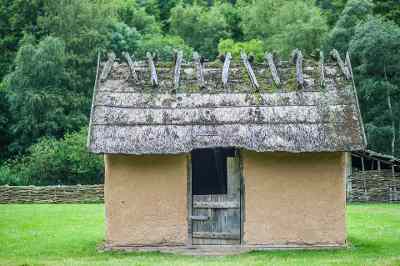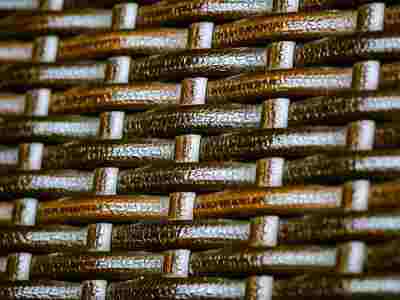कैसे एक मवेशी और डब हाउस बनाने के लिए
एक मवेशी और डब हाउस क्या है?वाटल और डब एक प्रकार के निर्माण को संदर्भित करता है जहां एक घर को लकड़ी के स्ट्रिप्स का एक जाली बनाया जाता है जिसे वटल कहा जाता है, गीली मिट्टी, मिट्टी, रेत और पुआल के साथ प्लास्टर/डब किया जाता है।
पहला भाग मवेशी है!मवेशी को पतली शाखाओं को बुनाई करके बनाया जाता है जो या तो पूरे होते हैं या ऊर्ध्वाधर दांव के बीच विभाजित होते हैं।आज एक विशिष्ट घर में 2x4 स्टड के रूप में दांव के बारे में सोचें और प्लाईवुड की दीवारों के रूप में बुनाई की शाखाएं।
 Daub अधिक कुछ भी नहीं है जो गंदगी और घास या कुछ इसी तरह से अधिक है और हालांकि यह सरल लगता है कि आपको केवल कुछ सामग्रियों का उपयोग करना चाहिए जो वास्तव में एक प्लास्टर/Daub है जो प्रभावी है। गुड डब में तीन चीजें, बाइंडर्स, एग्रीगेट और सुदृढीकरण शामिल होंगे।
Daub अधिक कुछ भी नहीं है जो गंदगी और घास या कुछ इसी तरह से अधिक है और हालांकि यह सरल लगता है कि आपको केवल कुछ सामग्रियों का उपयोग करना चाहिए जो वास्तव में एक प्लास्टर/Daub है जो प्रभावी है। गुड डब में तीन चीजें, बाइंडर्स, एग्रीगेट और सुदृढीकरण शामिल होंगे।
बाइंडर्स मिश्रण को एक साथ पकड़ते हैं और मिट्टी या चूने से बने हो सकते हैं, आमतौर पर मिट्टी। एग्रीगेट्स को डब सामग्री में जोड़ा जाता है ताकि इसे आगे बढ़ाया जा सके। एग्रीगेट आमतौर पर या तो रेत या छोटे कंकड़ होता है। सुदृढीकरण पुआल, बाल, घास द्वारा प्रदान किया जाता है और मिश्रण को एक साथ रखने के साथ -साथ संकोचन को नियंत्रित करने और लचीलापन प्रदान करने में मदद करता है, इसलिए रिबार सोचें। एक बार अच्छी तरह से मिश्रित होने के बाद डब को मवेशी पर लागू किया जाता है और सूखने की अनुमति दी जाती है।
ऊपर दी गई तस्वीर एक महान चित्रण है जो आप उम्मीद कर सकते हैं। घर की दीवारों पर ध्यान दें, जो एक तैयार डब दीवार दिखाती है। इसके अलावा, पृष्ठभूमि में बाड़ को नोटिस करें। बाड़ को एक ही सिद्धांत पर बनाया जाता है, जो कि डब की दीवार के रूप में है, बस डब के बिना।
जब घर की इमारत केवल संरचना की दीवारों को संबोधित करती है, तो एक मवेशी डब। छत और फर्श और दरवाजों को परस्पर जुड़ा जा सकता है। मैंने टाइल की छतों पर घास की छतें देखी हैं। आप किस छत का निर्माण करना चुनते हैं, यह पूरी तरह से आपके ऊपर है।
 The basic wattle wall consists of first setting forearm sized poles into the ground (or other material) at regularly spaced intervals, then small trees are cut down and weaved between the vertical poles in a horizontal alternating fashion that holds them firmly in place. The first horizontal weave starts at the ground and the wall is built up by placing successive horizontal limbs on top. Alternate the side of the vertical pole that the weaved limb go on so that the vertical poles remain straight, as the alternation of the weave prevents all of the force to be all in one direction resulting in the vertical poles bending inward or outward.
The basic wattle wall consists of first setting forearm sized poles into the ground (or other material) at regularly spaced intervals, then small trees are cut down and weaved between the vertical poles in a horizontal alternating fashion that holds them firmly in place. The first horizontal weave starts at the ground and the wall is built up by placing successive horizontal limbs on top. Alternate the side of the vertical pole that the weaved limb go on so that the vertical poles remain straight, as the alternation of the weave prevents all of the force to be all in one direction resulting in the vertical poles bending inward or outward.
The second picture is not of a wall, but of a basket. However, it is a great illustration of how the wattle wall is constructed. The only difference being, that the wattle wall will be made of larger sturdier material than the rattan basket pictured here. Refer to this picture to get a better understanding of the wattle concept.
After the walls are built the next step is to plaster the walls with your wet clay daub mixture. Be sure to use clay and not just regular dirt or the wall will surely not last.
Hair is a good reinforcement material, but grass is much more commonly used. Hair just isn't often available in the quantity needed.
Tips:
If at all possible construct the wattle wall on top of something instead of directly on the ground. Do this by having a foundation of timbers for each wall or even concrete or drilled stone. This will prevent the wall from deteriorating and greatly prolong the life of the wall.
It is important to note that a daub wall is not designed for load bearing. So to add a roof you will need to use the vertical poles as support with a cross member on top to build off of.
When applying the daub you will need to press it in firmly from both sides to completely cover the wattle. Be diligent to not leave any air pockets.
Since a daub wall is made of soil it will be subject to weathering by rain. It is possible to waterproof the walls to some extent by using Linseed oil aka Flaxseed oil. Simply paint the oil generously onto your cob/daub wall! If you do not have enough oil to do all the walls then start at the bottom and work your way upwards. The bottom will get wet first and stay wet the longest! Protecting the bottom will serve you best.
पहला भाग मवेशी है!मवेशी को पतली शाखाओं को बुनाई करके बनाया जाता है जो या तो पूरे होते हैं या ऊर्ध्वाधर दांव के बीच विभाजित होते हैं।आज एक विशिष्ट घर में 2x4 स्टड के रूप में दांव के बारे में सोचें और प्लाईवुड की दीवारों के रूप में बुनाई की शाखाएं।

बाइंडर्स मिश्रण को एक साथ पकड़ते हैं और मिट्टी या चूने से बने हो सकते हैं, आमतौर पर मिट्टी। एग्रीगेट्स को डब सामग्री में जोड़ा जाता है ताकि इसे आगे बढ़ाया जा सके। एग्रीगेट आमतौर पर या तो रेत या छोटे कंकड़ होता है। सुदृढीकरण पुआल, बाल, घास द्वारा प्रदान किया जाता है और मिश्रण को एक साथ रखने के साथ -साथ संकोचन को नियंत्रित करने और लचीलापन प्रदान करने में मदद करता है, इसलिए रिबार सोचें। एक बार अच्छी तरह से मिश्रित होने के बाद डब को मवेशी पर लागू किया जाता है और सूखने की अनुमति दी जाती है।
ऊपर दी गई तस्वीर एक महान चित्रण है जो आप उम्मीद कर सकते हैं। घर की दीवारों पर ध्यान दें, जो एक तैयार डब दीवार दिखाती है। इसके अलावा, पृष्ठभूमि में बाड़ को नोटिस करें। बाड़ को एक ही सिद्धांत पर बनाया जाता है, जो कि डब की दीवार के रूप में है, बस डब के बिना।
जब घर की इमारत केवल संरचना की दीवारों को संबोधित करती है, तो एक मवेशी डब। छत और फर्श और दरवाजों को परस्पर जुड़ा जा सकता है। मैंने टाइल की छतों पर घास की छतें देखी हैं। आप किस छत का निर्माण करना चुनते हैं, यह पूरी तरह से आपके ऊपर है।

The second picture is not of a wall, but of a basket. However, it is a great illustration of how the wattle wall is constructed. The only difference being, that the wattle wall will be made of larger sturdier material than the rattan basket pictured here. Refer to this picture to get a better understanding of the wattle concept.
After the walls are built the next step is to plaster the walls with your wet clay daub mixture. Be sure to use clay and not just regular dirt or the wall will surely not last.
Hair is a good reinforcement material, but grass is much more commonly used. Hair just isn't often available in the quantity needed.
Tips:
If at all possible construct the wattle wall on top of something instead of directly on the ground. Do this by having a foundation of timbers for each wall or even concrete or drilled stone. This will prevent the wall from deteriorating and greatly prolong the life of the wall.
It is important to note that a daub wall is not designed for load bearing. So to add a roof you will need to use the vertical poles as support with a cross member on top to build off of.
When applying the daub you will need to press it in firmly from both sides to completely cover the wattle. Be diligent to not leave any air pockets.
Since a daub wall is made of soil it will be subject to weathering by rain. It is possible to waterproof the walls to some extent by using Linseed oil aka Flaxseed oil. Simply paint the oil generously onto your cob/daub wall! If you do not have enough oil to do all the walls then start at the bottom and work your way upwards. The bottom will get wet first and stay wet the longest! Protecting the bottom will serve you best.
